The Economics and Statistics Division maintains archives of previous publications for accountability purposes, but makes no updates to keep these documents current with the latest data revisions from Statistics Canada. As a result, information in older documents may not be accurate. Please exercise caution when referring to older documents. For the latest information and historical data, please contact the individual listed to the right.
<--- Return to Archive
For additional information relating to this article, please contact:
December 06, 2021INTERPROVINCIAL WORKERS 2002-2018 Statistics Canada has recently released revised and updated information on the number of people who report work (T4) earnings in one province while residing in another province. This data is updated to 2018.
The number of net interprovincial workers refers to those coming to work in Nova Scotia from another province, less those leaving Nova Scotia to work in another province. Net interprovincial workers have declined since a peak of -10,130 in 2014 to -4,245 in 2018.

Over the period from 2002 to 2018, there was an overall rise in the number of interprovincial workers outbound from Nova Scotia to other jurisdictions peaking at 26,840 in 2014 (including returns filed late or subject to adjustment). In 2018, there wer 22,440 workers from Nova Scotia outbound for positions in other provinces. The number of workers inbound to work in Nova Scotia from other provinces has been more stable, though it has risen in the last two years of data to 18,195 in 2018.

The amounts earned by Nova Scotia workers in other provinces have declined to $921 million in 2018; these workers also reported $229 million earned inside the province. Incoming workers earned $457 million for their work in Nova Scotia and a further $317 million for work outside of Nova Scotia.

The rise in outbound interprovincial workers from Nova Scotia during 2002-2014 was concentrated in the construction sector and in oil/gas. Much of the decline in outbound workers from 2014-18 was due to a decline in outbound workers in these sectors.
The rising number of inbound workers coming to Nova Scotia from 2016-2018 was notably concentrated in transportation, professional/technical services, finance/insurance/real estate and information/culture.
Note that these data do not include those who filed late or had adjusted returns.

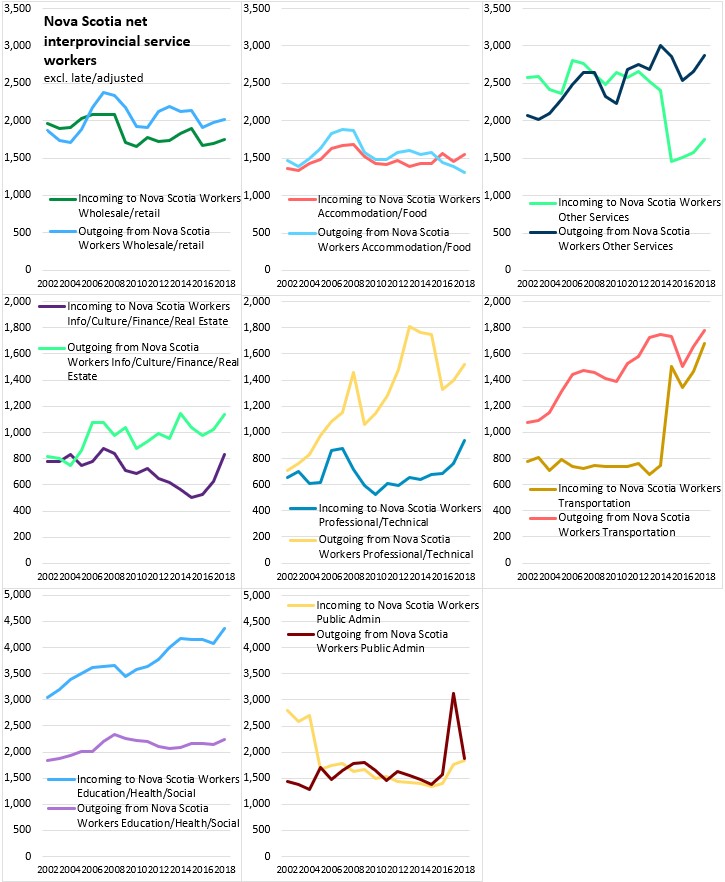
Nova Scotia has its largest interprovincial worker flows with four provinces: Newfoundland and Labrador, New Brunswick, Ontario and Alberta. Outbound interprovincial workers from Nova Scotia destined for Alberta have declined from 10,905 in 2014 to 4,865 in 2018. Net interprovincial workers between Alberta and Nova Scotia have declined from -8,995 in 2014 to -3,250 in 2018 (negative meaning more workers outbound from Nova Scotia than inbound from Alberta).
New Brunswick and Newfoundland and Labrador were net positive contributors of interprovincial workers to Nova Scotia in 2018 while Ontario and Alberta were net negative drains on interprovincial workers from Nova Scotia.
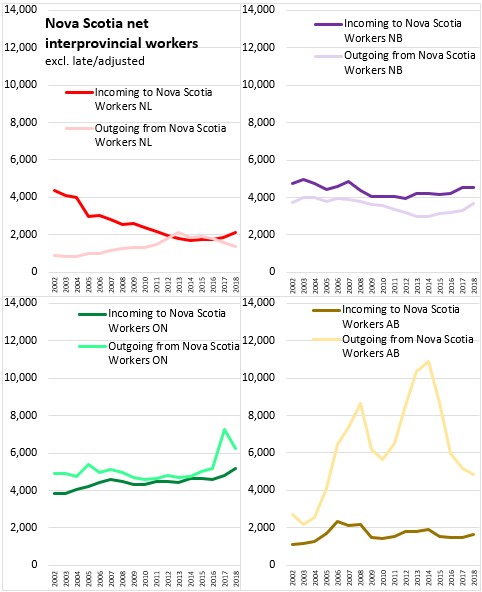
The volume of interprovincial workers are comparatively smaller for the remaining 6 provinces (vertical axis scales are 1/10th of those for Ontario, Alberta, New Brunswick and Newfoundland and Labrador).
There were net positive interprovincial workers from Prince Edward Island, a balance with Quebec (as many incoming as outgoing) and net negative interprovincial workers with all other provinces.
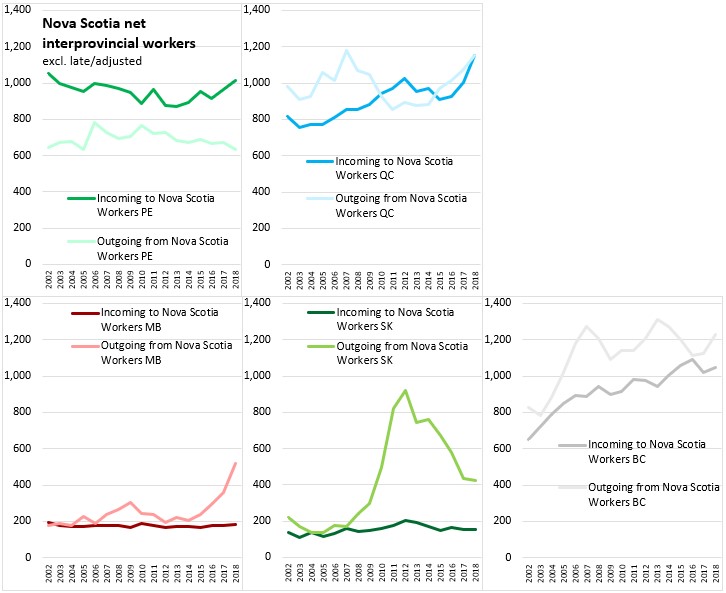
In 2018, the net impact of interprovincial workers (incoming less outbound) amounted to a drain of 1.0% on Nova Scotia's employment. This is measured as net interjurisdictional workers a share of resident workers plus those from other provinces working in Nova Scotia, less inbound workers to Nova Scotia. Only Ontario and Alberta reported a net gain in employment as a result of interprovincial workers in 2018.
In 2018, Nova Scotia had the third highest proportion of inbound workers (after Saskatchewan and Alberta) as well as the 5th highest share of outbound workers Note that those inbound from another province may not count the number who work in both their home province and another province.
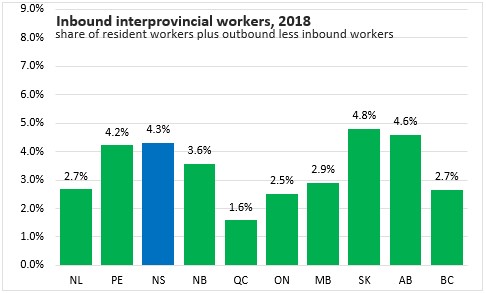
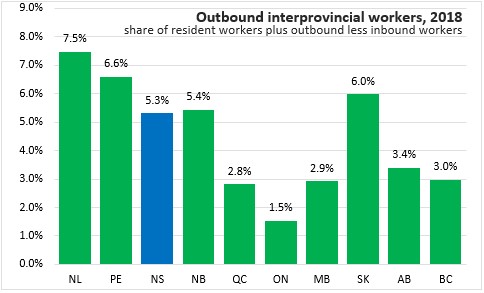
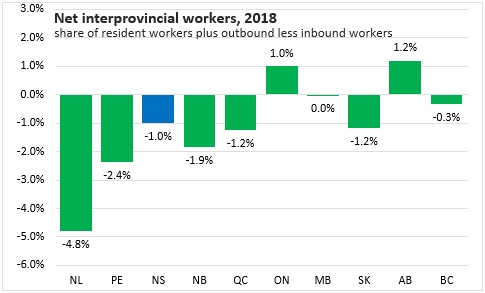
Interprovincial workers had been a net gain for Nova Scotia from 2002 to 2004. Compared with the rest of Atlantic Canada, Nova Scotia had a smaller net drain due to interprovincial workers in 2018. The Maritime provinces all experienced less net interprovincial worker outflow, but Newfoundland and Labrador's net outflow increased.

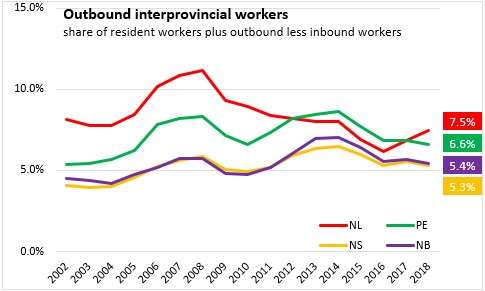
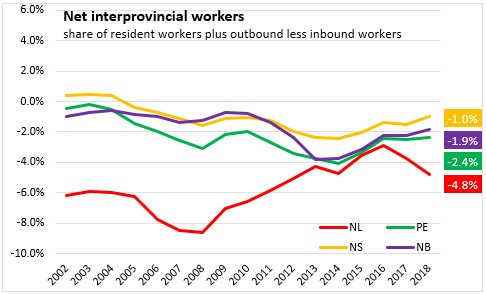
Interjurisdictional work was less common (either inbound or outbound) in the three large urban provinces of Ontario, Quebec and British Columbia.



Interjurisdictional work was prevalent in Alberta and Saskatchewan during the periods of large investments in resource production. Since 2014, lower commodity prices have slowed investment in resource production and inbound interjurisdictional workers have slowed for resource intensive provinces as well.
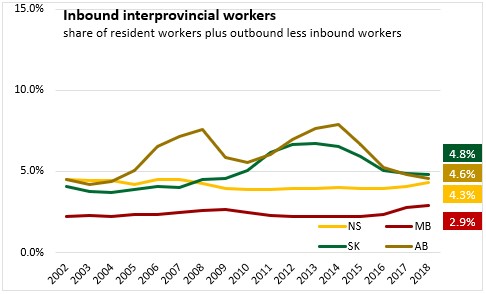
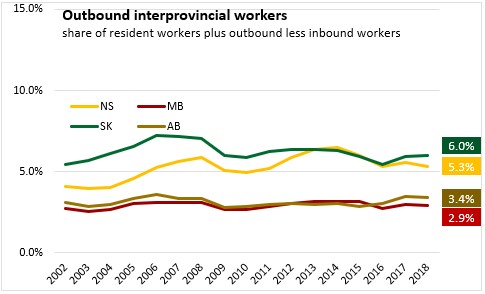

The composition of Nova Scotia's outbound interprovincial workers was disproportionately male. Incoming workers to Nova Scotia were also disproportionately younger and male, but to a lesser extent than observed among outbound workers.


There is a larger number of interprovincial workers aged 18-24, and in recent years this group has reported a notable decline in outgoing workers. The number outbound interprovincial workers from Nova Scotia in older cohorts has also slowed in recent years.

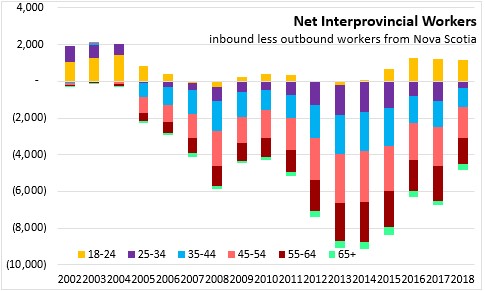
Source: Statistics Canada, Estimates of Inter-jurisdictional Employment in Canada by Province and Territory, 2018
<--- Return to Archive